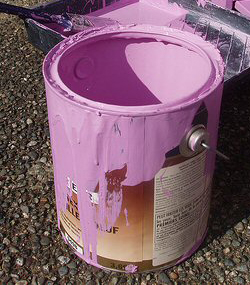 The other day I decided to finally start working on my dining room and get some quotes from painters. You would think that hiring a painter would be easy, especially in “this economy” when everyone is looking for work. Much to my surprise, I had to work at it.
The other day I decided to finally start working on my dining room and get some quotes from painters. You would think that hiring a painter would be easy, especially in “this economy” when everyone is looking for work. Much to my surprise, I had to work at it.
After getting referrals from three friends, I started calling. One company called back right away, another called within a couple of days, and one never called back at all. When the two companies who were still in the game came to look at the job, I was surprised by their proposal process.
One painter didn’t have the details I needed about things like who would supply the paint, how many days it would take to do the job, and whether his workers would help to move the furniture, etc. I had to play phone tag with him for a while to get my questions answered. The other painter had the details I was looking for, but I had to call the company twice to get them.
Since interacting with prospects and clients is so important for any business and happens (hopefully) all the time, I wondered why these small companies didn’t have a system in place to make this process as efficient as possible. If you think about it, my goal was to hire a painter and give that painter my m-o-n-e-y. So why the disconnect? And what should you do to make sure that your business doesn’t have one?
Be a detective.
Get your staff together and have them show you their “tracks.” Find out exactly what happens when…
…someone requests a proposal. Do you have a several proposal templates ready to go for various jobs, or do you create them from scratch every time? Within how many days/hours after you scope out the job do you send the proposal? When and how do you follow up?
…someone wants more information. Do you write down their name and contact information?What happens if they don’t hire you right away? How do you track them? Do they ever hear from you again?
…someone refers a new customer. Do you thank them?How do you thank them? Who is the thank you from, and how quickly does it get sent?
…someone becomes a new customer. Do you contact them after the work is finished to find out how it went? Do you ask them to refer you to their friends? How do you keep in touch with them once the job is over?
…someone has feedback. Who responds? How do you handle feedback that’s negative? How do you share it when it’s positive? If you hear the same complaint over and over, do you do something about it?
Establish a system that everyone can follow.
I bet you’ll be really surprised by what you find once you start asking these questions. If you’re like most of the businesses I work with, you probably don’t have any kind of formal system that people have been trained to follow. In fact, each person will probably have their own system – notes on pieces of paper, a notebook, a spreadsheet – you name it.
The problem there is that your business is relying on someone’s memory, or an idiosyncratic system that no one else knows how to run. If the person who devised the system is not there, or they forget to do something, things and opportunities could fall through the cracks.
So do yourself a big favor. Before you spend a bunch of money trying to get more people to your door with Google, search engine optimization, and email campaigns, ask yourself this question: When your phone starts ringing, are you ready?
Stop asking customers to step over obstacles that get in the way of them hiring you. Make an investment in an efficient, reliable system that makes doing business with you as easy as knocking over a can of paint.
